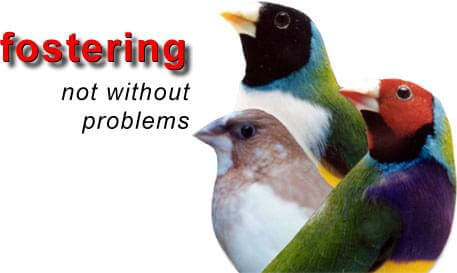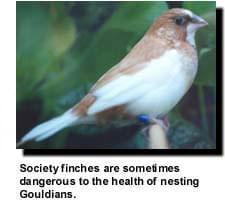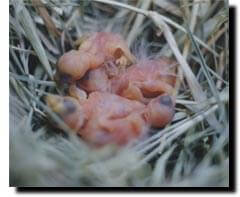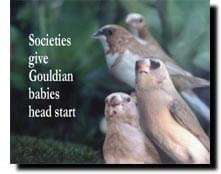 Article on Fostering and it's problems
Article on Fostering and it's problems
Article on Fostering Lady Gouldian Finches
Articles and Information - Lady Gouldian Finch
I have found that some young Gouldian parents can be undependable. They will lay eggs but not sit or they will abandon the eggs after several days. The most frustrating behavior I have observed is the throwing out of the young babies from the nest. Nothing is more disheartening than to loose eggs or nestlings from this behavior. Keeping Society Finches will solve this problem as they will readily accept the Gouldian eggs or nestlings as their own.
 Pied Society finch
Pied Society finch
Societies have been used for centuries of birdkeeping to foster species of birds that were not adept at raising babies in captivity. They have also been used to foster clutches for species when new mutations were being developed since many more offspring can be produced this way.
"Carriers" of several diseases
However using Society (Bengalese Finches) as foster parents is not without problems. While it is true that they have been bred over the years to improve the stock birds that make the best parents, all Society Finches can become "carriers" of several diseases that will not affect them or their own offspring but could prove lethal to species of birds that have evolved in dry, arid conditions. These "wet" diseases are Campylobacter and Cochlosoma.
Once a Society Finch has become infected with either of these diseases, they cannot be "cured". This is known as being a "carrier." The disease will just remain in their body, ready to infect any species that has not developed an immunity against it. Gouldian Finches fall into the category of dryland species that will be negatively affected by Campylobacter and Cochlosoma. Your vet can perform tests to see if your society finche are carrying either of these diseases.
 Society Finch hatchlings
Society Finch hatchlings
While both diseases can be "kept in remission" during a breeding season to allow Society finches to foster Gouldian chicks, I would not recommend doing it. By constantly medicating the Society Finches, you are also medicating the chicks. This constant medication does not allow the chicks to develop their own strong immune system and, therefore, the chicks produced will always be weak.
Campylobacter treatment
The medications to treat Campylobacter are Tetracycline and Doxycycline. These drugs can only be given to the Society Finches before the eggs hatch because the medication will have adverse effects on the growing chicks. You will have to hope that the disease does not surface again until the chicks are weaned and independent (7 weeks). You would then medicate again during the next incubation go around. Erythromycin is the drug of choice. If Erythromycin is not available it is my understanding that both Tetracycline and Doxycycline can also be used to treat the Campylobacter. But neither of these drugs are recommended for young chicks, so the same treatment schedule should be used as mentioned above for the Erythromycin.
Cochlosoma treatment
The drug of choice for Cochlosoma is Ronivet 12%. This drug is safe it will not hinder development of the chicks, but will subdue development of their immune system to give to the Society Finches after the chicks hatch. However, it may be necessary to treat with Ronex every other week for the entire time the chicks are being fed, until they become independent.
Setting up Society to foster
With this information in mind, I have found that most Society Finches do need to be in the "breeding mode" before they will successfully raise chicks. To see if they are receptive to incubating eggs if they have not started laying their own, you can give them infertile eggs from a previous clutch of eggs, or even the small plastic finch eggs. Just remember that in my experience, even if they begin incubating the eggs, they may not feed or care for the hatched babies if they are too young (not sexually mature.) And, contrary to popular belief, not every Society Finch will be a good parent.
Breeders differ on foster pairing
Society Finches that are laying their own eggs will usually accept both eggs and just hatched live babies from another pair of birds. However, I have found that they are more likely to do this if they have been allowed to raise a clutch of their own babies first. This is not the information I received when getting started with fostering. Most breeders believe that you should never allow Society Finches to raise their own babies first, as this will predispose them to rejecting chicks of other species. For instance, Gouldian chicks have distinct mouth markings along the edge of their mouths to facilitate the feeding parents in the darkened cavities where they breed in the wild. Society chicks do not have these markings. But my experience has not been the rejection of Gouldian chicks after Society Finches have raised a clutch of their own.
Society Finches can be paired as foster parents in the following way:
* 1 cock and 1 hen
* 2 hens
* 3 cocks
Best results
The second two scenarios will usually result in better success since same sex pairings will not want to start a second clutch before the first clutch is independent. This is important when using Society Finches as foster parents because Society Finches do not feed their own chicks as long as Gouldian parents would feed theirs. So if a cock and hen pair begin breeding again before the chicks are ready to be on their own, they can sometimes neglect the first clutch of chicks before the chicks are ready to be on their own. Even though Gouldian chicks may not get as much food while being fed by Society parents, they will make up for lost time once they start eating on their own. So while they make be smaller in stature upon weaning, they will be about matched to chicks raised by Gouldian parents by 3-4 months of age.
 Society Finches
Society Finches
Societies give babies head start
If the Gouldian parents aren?t eating a varied diet, using societies as foster parents give the Gouldian babies a better head start in life. Since Societies eat a variety of different foods, they will feed the babies those same foods. Unless the Gouldian parents are also eating a varied diet their babies will most likely get only seed while they are developing.
Airsac mites
I have read several articles that state if you want to stop the transfer of airsac mites to the Gouldian babies, use the Society finch to foster. The article says that Society finches do not get this mite. In my experience I do not find this to be true. Society should be treated the same as Gouldians with the SCATT or Moxidectin treatment.
Imprinting
When Society Finches are used to foster any other species bird, it is important to remove the chicks from the Society parents as soon as possible (being independent) so that they do not "imprint" on the Society Finches and later in life reject pairing with other Gouldians.
© lady gouldian finch.com 2017